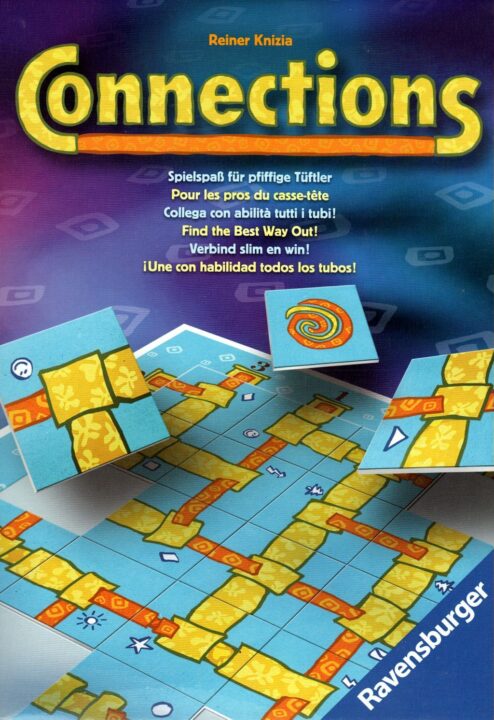Alright, gather around the table because it’s time for my honest review of Connections! If you’ve ever wanted a party game that puts your brain and wit to the test (without giving you a migraine), this one’s for you. After roping in a few friends—and bribing them with snacks—I put this game through its paces. From the easy-to-grasp rules to some sneaky moments of luck, I’ve got all the ups and downs covered. Grab a drink, and let’s see if this game is worth your shelf space—or if you should leave it at your cousin’s house after game night.
How It Plays
Setting Up
Take out the deck of Connections cards and shuffle well. Place the deck in the center. Make sure everyone has some paper and something to write with. Choose someone to be the first clue giver. Don’t let Phil be the clue giver unless you want chaos!
Gameplay
On your turn as the clue giver, draw four cards and secretly group them into two pairs that have something in common. Give the rest of the group a hint to help them guess the connections. Everyone else scribbles down their wild guesses, and chaos usually follows—especially if snacks are involved.
After guesses are made, reveal the correct pairs. Players score points for correct matches. Then pass the clue giving torch (figuratively, please—don’t actually burn anything) to the next player and repeat.
Winning the Game
The game continues until everyone has been the clue giver the same number of times or you run out of cards, whichever happens first. The player with the most points gets bragging rights and—if you play with my friends—the last slice of pizza.
Want to know more? Read our extensive strategy guide for Connections.
Easy to Learn, Hard to Master: How Connections Nails the Rulebook
When I sat down to play Connections with my friends, I had flashbacks to other party games where the rules booklet seemed written in ancient runes. Thankfully, Connections keeps things simple. The instructions fit on one tidy sheet. There are no plot twists or hidden rules waiting to jump out and trip you. You grab your color-coded cards, read the big, bold prompt, and start linking up words. Everyone can start playing within five minutes—faster if you bribe the group with snacks.
The core mechanic in Connections is clever: you arrange words on the table and try to group them by a hidden theme before anyone else. You get points for spotting links no one else sees. Imagine a round where someone links “apple,” “keyboard,” “pie,” and “Newton.” You’re left wondering if you just failed a pop quiz or if your friends are actual geniuses.
There’s zero ambiguity about what you do on your turn. You can only make one grouping per round, and the components have symbols so you can’t even get confused if you’re colorblind (which is a big plus). As a team who once spent twenty minutes arguing over what a meeple was in another game, we found this refreshing.
However, if you’re hoping for deep strategy, Connections doesn’t have layers. It lives or dies on your group’s imagination and wordplay skills. The rules don’t get in your way, but they also don’t give you secret power-ups or wild card twists. If you want chaos, you’ll need to bring the drama yourself.
Stay tuned—next I’ll crack into whether Connections keeps you coming back for more, or if it ends up stuck at the bottom of your closet with that talking Monopoly hat.
Replayability and Player Engagement in Connections
Let me just say, Connections has some serious replay legs. The game managed to keep my friend group glued to the table, even after three full rounds. (This never happens. We usually lose someone to TikTok during round two.)
The secret sauce is in how the categories and connections change every time. Even when you think you’ve nailed the logic behind the groupings, Connections tosses you a curveball—like that time my buddy swore “apple” and “car” belonged together because, apparently, he’s seen a fruit-shaped car once. No two games ever feel the same, and watching your pals pitch silly connections is half the fun.
Another win: players are always involved. There’s zero down time in Connections. You’re either puzzling over words, debating categories, or laughing at wild guesses. There’s no “wait for your turn while checking Instagram” because everyone’s brain gets a workout, all the time. It definitely brings out the competitive spirit—even my usually quiet friend started arguing passionately that “banana” fit in the same group as “phone.”
If you play often, you might start to notice similar word themes, but Connections tosses in enough variety to keep things spicy. It’s a game that won’t collect dust, since everyone asks for “one more round.” Engagement never drops, unless someone leaves for a snack crisis.
Next up: We’ll find out if Connections is a brain game or just a lottery in disguise. Time to settle the skill versus luck debate!
How Fair is Connections? Skill vs. Luck Showdown!
Let’s talk turkey: balance. Some games tip the scales so far towards luck, you may as well just roll a potato instead of dice. But Connections? Well, it sits somewhere in the magical middle. You need a decent noodle on your shoulders, but you won’t get stuck just because you forgot your thinking cap at home.
In Connections, you’re tasked with grouping words together in a smart way. Now, this sounds easy until your friend picks out the most bonkers connections (“How could you possibly link ‘Socks’ with ‘Saturn’?” – a real dispute at my table). That’s where skill comes in. It’s not about luck of the draw, it’s about thinking laterally and knowing how your mates think. If you’re good at reading people, you’ll have a real edge. And if you’re not, well, at least you’ll have some odd stories.
It’s not totally luck-free, though. Sometimes you just don’t click with the weird logic of the person who wrote the cards. Once, my mate Dave guessed ‘Nuts’ and ‘Bolts’ were linked because “they both start with ‘N’ if you squint hard enough.” Not helpful, Dave. But overall, Connections rewards creative thinkers and punishes those who simply rely on the universe to hand them a win. I never felt cheated by randomness. So if you hate games that make you shake your fists at the sky, this one’s for you.
Now, if you think good gameplay deserves to be dressed up nice, just wait till you hear about its looks and feel in the next section!
Component Quality and Visual Appeal in Connections
Let’s talk about the stuff you actually hold in your hands while playing Connections. I’m a sucker for a board game that feels good to touch, and Connections mostly delivers here. The cards come on nice, thick stock, so you won’t have to worry about your friend Steve spilling his soda and leaving you with limp, sad cards. (Why is it always Steve?) All the printing is sharp and easy to read, which saves me from squinting like a detective in a bad movie.
The box art is simple but colorful. It pretty much says, “Hey, inside here is a good time!” and doesn’t overpromise. The design itself won’t win any art awards, but you’ll never lose track of what’s what on the table. Icons are clear, fonts are readable, and nothing tries too hard to look fancy. If you’re used to games that shove miniatures and five-pound rule books at you, Connections goes the opposite way. It’s friendly, it’s bright, and it doesn’t try to be the Mona Lisa of games.
Now, is Connections the flashiest game on the shelf? No way. But at least you won’t need a microscope to see the words or a YouTube tutorial to repack the box. I’ve played it a bunch and the components are still holding up, even after a run-in with my cat, Pickles. The game scooped up no style points, but it wins for practicality.
Overall, if you want a game that looks approachable and doesn’t fall apart after one night, this is it. I absolutely recommend Connections for its solid, no-nonsense build!
Conclusion
So, wrapping things up! Connections is a solid pick if you like quick, clever games that actually make you think. The rules are crystal clear, it rewards smarts over luck, and it’s easy to pull off your shelf for any game night. Sure, the art won’t blow your socks off, but everything is sturdy and does the job. We had a blast playing and there was plenty of banter (and the odd, heated debate) at my table. If you’re sick of games where dice rule your fate, this one deserves a spot in your collection. That’s it for my Connections review—thanks for sticking with me to the end!


